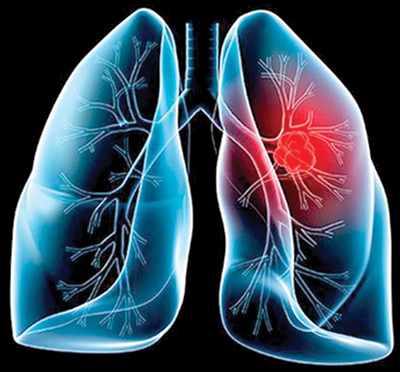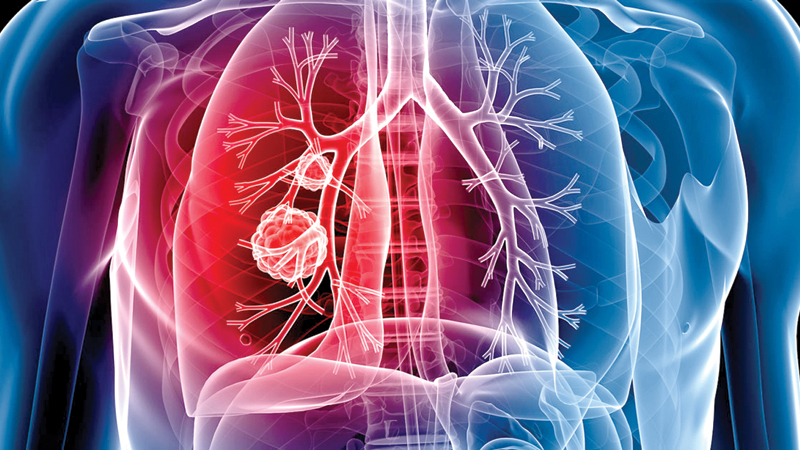 Lung Cancer Awareness month which began on November 1 ending November 30, 2023 this year brings global attention to a subject which has caused concern among health officials across the world; namely the sharp rise in the number of new Lung cancer cases being detected.
Lung Cancer Awareness month which began on November 1 ending November 30, 2023 this year brings global attention to a subject which has caused concern among health officials across the world; namely the sharp rise in the number of new Lung cancer cases being detected.
Reducing these cases with more awareness raising and education of the public as a whole is the only way to halt this disturbing trend according to oncologists and physicians involved in treating cancer patients.

Dr. Janaka Godevithana
The Sunday Observer spoke to Senior registrar in Community Medicine National Cancer Control Programme Dr. Janaka Godevithana to find out more about how this daunting task could be achieved and the best way to do so.
Excerpts.
Q. This month is Lung Cancer Awareness month where the focus of attention will be on a month- long series of activities and initiatives to promote lung health and cancer awareness. Since many readers still don’t know exactly what the specific role of the lungs are, could you enlighten them?
A. Lungs are soft structures located in the chest cavity. There are two lungs, namely right and left. The primary function of the lungs is air exchange. Simply, it puts out carbon dioxide produced in the body and takes in oxygen which is an essential material for body functioning. Apart from that, lungs play a crucial role in balancing body pH, protecting the body from diseases and speech.
Q. So how does one get Lung Cancer?
A. Generally, cancer is an abnormal cell growth that can affect the structure and function of the respective part or the organ. Similarly, lung cancer is an abnormal growth of lung cells that alters lung functions, and it can distort its structure and spread to adjacent and distant tissues and affect their structure and functions as well.
Q. Is Lung Cancer an urgent health issue? Why is it necessary to devote an entire month to raising awareness on this specific health topic amidst other equally pressing health issues?
 A. Because lung cancer is a leading cause of death worldwide accounting for more than 1.8 million deaths worldwide and most of the lung cancers are detected at advanced stages. As the risk factors have been identified, prevention is possible. This is why raising more awareness of lung cancer plays a pivotal role in the battle against lung cancer. Raising awareness of risk factors, symptoms and signs and treatment options will be beneficial for prevention, early detection and proper treatment for lung cancers for all.
A. Because lung cancer is a leading cause of death worldwide accounting for more than 1.8 million deaths worldwide and most of the lung cancers are detected at advanced stages. As the risk factors have been identified, prevention is possible. This is why raising more awareness of lung cancer plays a pivotal role in the battle against lung cancer. Raising awareness of risk factors, symptoms and signs and treatment options will be beneficial for prevention, early detection and proper treatment for lung cancers for all.
Q. Gender -wise who are more vulnerable to developing it?
A. According to the cancer incidence data 2020 lung cancer is the second most common cancer among males, and it is at 9th place in the top ten cancer list for females. However, when 1628 lung cancers were reported among males in 2020, 627 lung cancers were reported among females. So we can’t just ignore females having lung cancers.
Q. Lung cancer is one of the biggest cancer killers in the UK claiming over 35,000 lives a year. How does Sri Lanka compare with these statistics according to your latest figures in the National Cancer registry?
A. Lung cancer was the top cancer leading to death among males and third among females. It accounted for 5.5 deaths per 100,000 populations in 2015.
Q. Do the figures indicate a rise or a decline in the number of cases now prevalent in Sri Lanka?
A. As with all cancers, lung cancer incidence is rising in the country. For example in 2020 the total number of lung cancer cases was 2255.
Q. In general, what are the causes and risk factors that drive this disease? Smoking and Air pollution have been cited as two of the biggest risk factors. Which of them is the main culprit?
A. Smoking is the main and well-established risk factor for lung cancers. Other than that exposure to hazardous materials or chemicals, air pollution, genetic diseases and chronic lung diseases are other risk factors.
Q. Can a non-smoking person be exposed to lung cancer? How?
A. Yes, exposure to second-hand/ passive smoking can lead to lung cancers. On the other hand, anyone can get cancer even without having any risk factors. What happened with risk factors is, increasing the likelihood of getting cancers
Q. Will a passive smoker experience the same level of risk of lung cancer as an addicted smoker?
A. Intensity of the exposure is a key consideration in these risk factors. Therefore, addicted smoker carry an increased risk compared to a passive smoker
Q. What about the family history of lung cancer? How high is it on the risk list?
A. Yes. genetic predisposition has a role in developing lung cancers. Therefore, one with a family history of lung cancer bears a greater risk of developing lung cancer.
Q. If a person has undergone radiation therapy to the chest area as a treatment modality for some other cancer, does he/she face a higher risk of developing lung cancer later in life?
A. Radiation used in radiotherapy can induce a transformation of a normal cell to a cancer cell and it can be considered as a risk factor. However, with the advancements in treatment modalities, targeted and precise radiotherapy can be given to the cancer, minimising exposure of other areas to radiation.
Q. What about exposure to harmful chemicals at workplaces?
A. Yes. Most industrial chemicals can damage cells and transform them into cancer cells with repeated and prolonged exposure.
Q. Radon exposure has also been cited as a risk factor. What is Radon exposure?
A. Radon is a naturally occurring gas that forms when uranium, thorium, or radium, which are radioactive metals, break down in rock, soil, and water. It has been found to be carcinogenic and it is the second most common cause of lung cancer in the USA.
Q. As air pollution is now common in most cities and towns even leaving permanent smogs, can you tell us more about how it affects the lungs and could lead to lung cancer?
A. This is because most polluted air in the cities contains several carcinogens such as lead, carbon monoxide, particulate matter, etc. which can lead to lung cancers as well as chronic respiratory diseases in long-term exposure.
Q. Exposure to other carcinogens in the air due to outdoor burning of waste materials including polythene and plastics which release toxic chemicals including dioxin to the environment – can they lead to lung cancer?
A. Outdoor burning of waste (mostly polythene and plastic) can lead to incomplete burning and release many carcinogens and they can lead to lung cancers in the long run .
Q. What are the symptoms of lung cancer to watch out for? Are they visible at an early stage?
A. There are no specific symptom/s to suggest lung cancer. However, a prolonged cough, chest pain, shortness of breath, blood-stained sputum (Haemoptysis), weight loss, and recurrent chest infections can be symptoms of lung cancer.
Q. Can these symptoms be mistaken for some other disease? If so give some examples
A. Yes. A range of diseases from simple respiratory tract infections to chronic disease like TB can give rise to the above symptoms. Systemic diseases such as anaemia, heart disease, and kidney disease can also share some common symptoms with lung cancers. Therefore, careful evaluation with history, examinations and investigation is necessary to diagnose lung cancer.
Q. If tested and treated early can these symptoms be reversed?
A. Yes. At early stages where the cancer is confined to the lungs and not spread to other organs effective treatment modalities are available and it is curable.
Q. Are there different stages in its progress?
A. Yes. Lung cancers can be of two major stages. The early stage is where the cancer is confined to the lungs and not spread to other organs. And the late stage is where the cancer is spread either to adjacent tissues or distant organs.
Q. What are the symptoms when it reaches a more advanced stage?
A. Apart from the symptoms mentioned above, late or advanced-stage cancer will show symptoms of distant organ involvement. Lung cancers can spread to the liver, brain and bones. It can show local spread as well. If spread to the brain it can present with headaches and fits. If it spreads to the bone it will present as bone pain or fractures.
Q. How do you prevent or reduce risks of lung cancer? I understand the Health Ministry and NCCP have jointly put out some guidelines on what to do and what not to do. What are they?
A. The Health Ministry has identified key risk factors for Non-communicable Diseases (NCD) to which cancers are also included.
Those key risk factors are using tobacco (smoking and smokeless tobacco), alcohol, unhealthy diet and physical inactivity. Under the directorate of NCD, the NCD unit and NCCP conduct programs to reduce these risk factors by addressing different groups of people in different channels and modalities.
Screening for the above risk factors is being carried out throughout the country at healthy lifestyle centers (HLC) located at each primary care institution (District hospitals and Rural hospitals).
Guidance to minimise risk factors and follow-up of people with risk factors is done at HLCs
Q. Is the treatment freely accessible countrywide?
A. Treatment for detected lung cancers is available at cancer treatment centres around the country.
Q. What are the main gaps you see in the present health system in delivering optimal care for lung cancer patients and how do you wish to close them?
A. One of the main gaps is the delivery of health-related information to the public. The main channel we have is the preventive healthcare staff (Medical Officer of Health, Public Health Inspector, and Public Health Midwife). However, the availability of other channels such as mass media or social media is minimal on a regular basis. On the other hand, uptake of available screening services is suboptimal among the target population.
Finally, the facilities and capacity of the curative health sector are not adequate to effectively treat patients with lung cancers. Specially advanced surgical treatments are not possible due to non-availability of advanced facilities.
Q. Any future plans?
A. We are planning to reach more and more groups of people with health-related information on risk factors for cancers and other NCDs through different channels including social media and mobile and web-based information sharing.
We are planning to establish a good monitoring system to strengthen screening for risk factors for screening at HLC with the NCD unit and directorate.
Q. Have you a message for the public on how to avoid the risks of lung cancer?
A. As the link between smoking and lung cancer is well established, avoid smoking to prevent lung cancers and refrain from other key risk factors to get rid of NCDs and have a good quality life.
Q. Is there a hotline where a reader wishing to obtain more information can reach you?
A. The NCCP website provides more information on cancers in Sri Lanka. 1948 is a free number for getting ‘Quit Smoking’ advice and information









